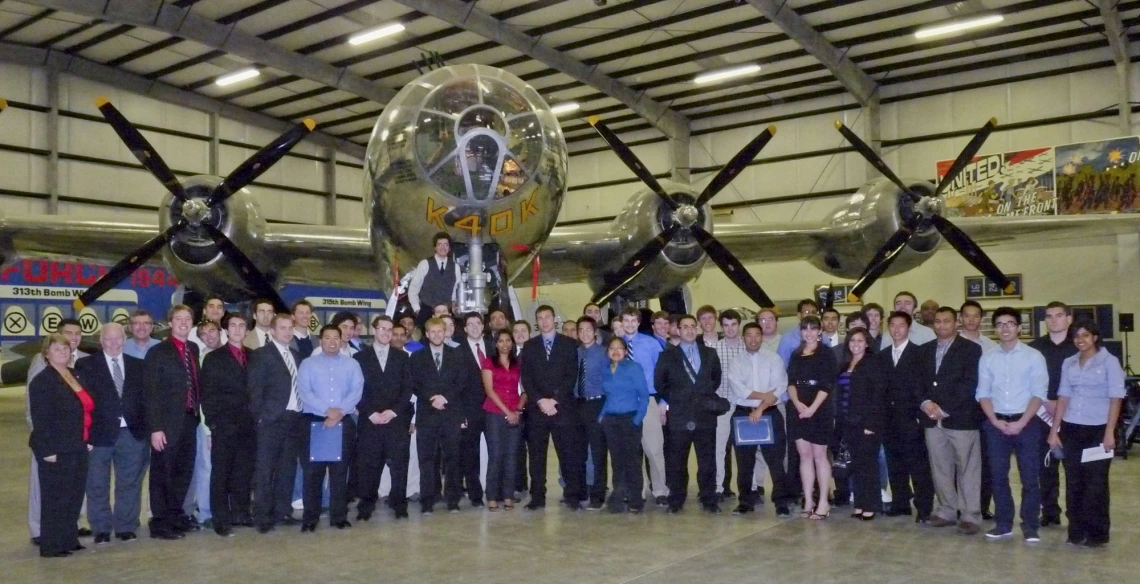Year in Review: UA Student Branch, American Institute of Aeronautics and Astronautics
Aerospace engineering senior Ryan Crompton, president of the UA student branch of the American Institute of Aeronautics and Astronautics, or UA-AIAA, reflects on a busy year for the club.

Attendees of the Region VI Student Paper Conference assemble in front of a Boeing B-29 Superfortress on display at the Pima Air & Space Museum in Tucson, Ariz.
With the spring semester behind us, we can relax and look back on all we accomplished this year. As in the past we competed in the AIAA Design/Build/Fly competition. In addition, to build our student branch and enhance our reputation in the AIAA community, we hosted the Region VI Student Paper Conference.
Design/Build/Fly
Design/Build/Fly is a yearly event sponsored by Cessna Aircraft Company and Raytheon Missile Systems that brings together university students from all over the world to compete in aeronautical design, production, flight, and technical writing. The rules are released in late August and the competition is held mid-April, so contestants have around eight months to design a plane from the ground up.
The 14th annual competition was held in April 2010 at Cessna Field in Wichita, Kan. A total of 69 teams submitted written reports to be judged, and 65 teams attended the fly-off. All teams completed the technical inspection and 62 teams made at least one flight attempt. More than 600 students, faculty, and guests were present.
The most difficult design challenges included designing a plane that could be variably loaded with six to 10 softballs and up to five softball bats; only using off-the-shelf electrical propulsion systems limited by four pounds of nickel-cadmium or nickel-metal hydride batteries; and a final travel size of two feet by two feet by four feet.
Using computer-aided design techniques, rapid prototyping, wind tunnel testing and some destructive testing, our final design was a mammoth plane called Ground Out. With a huge wingspan of almost eight feet and a take-off weight of 15-23 pounds, depending on the mission, Ground Out proved to be a stable and agile flyer. With help from many local sponsors including but not at all limited to Raytheon Missile Systems, the UA College of Engineering, and Hobby Town USA, the plane was completed and flew in January.
After some test flights and writing a 45-page design and testing report, we left for Wichita in a 15-passenger van for what would be a 21-hour drive. We arrived in Wichita the day before the competition, which gave our team an opportunity to visit historic downtown Wichita. It was a unique experience and I can tell you that it doesn't feel like the rest of Wichita.
Over the next three days we completed all three required missions. We were only one of 13 teams to do that, and were repeatedly praised as having a plane "someone might feel comfortable flying in." By the end of the weekend more than 15 planes had crashed and we landed in 22nd place out of 65.
This year's team played a major part in our program to develop our Design/Build/Fly performance, by using new techniques and contributing members to next year's team. Our aim next year is to place in the top 12, but this will require us to build both our skills and our list of sponsors. Look forward to big things in the future.
Region VI Student Paper Conference
Each year a different university in the Western U.S. hosts the annual Region VI Student Paper Conference, which brings together students from the region to present their research to a group of their peers and technical judges. They can present in any of three categories: undergraduate, master's and team.
The UA's planning committee consisted of 10 very dedicated people who prepared and ran every aspect of this year's conference. Their jobs included everything from advertising to coordinating room accommodations to supplying food and even finding the technical judges for each day. After months of preparation students began to arrive March 25 at the Hyatt Place Hotel at Tucson International Airport, which would be their home for the next three days and where they would do all their presenting.
After a quick catered lunch presentations began and continued until a bus arrived to take conference delegates to the UA campus for a tour of aerospace research labs. After the tour, Roberto Furfaro, assistant professor in the department of systems and industrial engineering, spoke on future U.S. space missions and how UA plans to be involved.
During the second day's presentations, UA-AIAA's Emily Springer talked about the importance of staying an AIAA member. The final day began with presentations and ended with a closing ceremony at Pima Air and Space Museum.
Our students did a great job preparing for the event but it wouldn't have been possible without all the help we received from our fellow AIAA members, especially Jane Hansen, the Region VI deputy director of education. We would also like to thank all our local Tucson section members.

